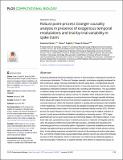Robust point-process Granger causality analysis in presence of exogenous temporal modulations and trial-by-trial variability in spike trains
Author(s)
Casile, Antonino; Faghih, Rose T; Brown, Emery Neal
DownloadPublished version (3.373Mb)
Publisher with Creative Commons License
Publisher with Creative Commons License
Creative Commons Attribution
Terms of use
Metadata
Show full item recordAbstract
Assessing directional influences between neurons is instrumental to understand how brain circuits process information. To this end, Granger causality, a technique originally developed for time-continuous signals, has been extended to discrete spike trains. A fundamental assumption of this technique is that the temporal evolution of neuronal responses must be due only to endogenous interactions between recorded units, including self-interactions. This assumption is however rarely met in neurophysiological studies, where the response of each neuron is modulated by other exogenous causes such as, for example, other unobserved units or slow adaptation processes. Here, we propose a novel point-process Granger causality technique that is robust with respect to the two most common exogenous modulations observed in real neuronal responses: Within-trial temporal variations in spiking rate and between-trial variability in their magnitudes. This novel method works by explicitly including both types of modulations into the generalized linear model of the neuronal conditional intensity function (CIF). We then assess the causal influence of neuron i onto neuron j by measuring the relative reduction of neuron j's point process likelihood obtained considering or removing neuron i. CIF's hyper-parameters are set on a per-neuron basis by minimizing Akaike's information criterion. In synthetic data sets, generated by means of random processes or networks of integrate-and-fire units, the proposed method recovered with high accuracy, sensitivity and robustness the underlying ground-truth connectivity pattern. Application of presently available point-process Granger causality techniques produced instead a significant number of false positive connections. In real spiking responses recorded from neurons in the monkey pre-motor cortex (area F5), our method revealed many causal relationships between neurons as well as the temporal structure of their interactions. Given its robustness our method can be effectively applied to real neuronal data. Furthermore, its explicit estimate of the effects of unobserved causes on the recorded neuronal firing patterns can help decomposing their temporal variations into endogenous and exogenous components.
Date issued
2021Department
Massachusetts Institute of Technology. Department of Brain and Cognitive Sciences; Picower Institute for Learning and MemoryJournal
PLoS Computational Biology
Publisher
Public Library of Science (PLoS)